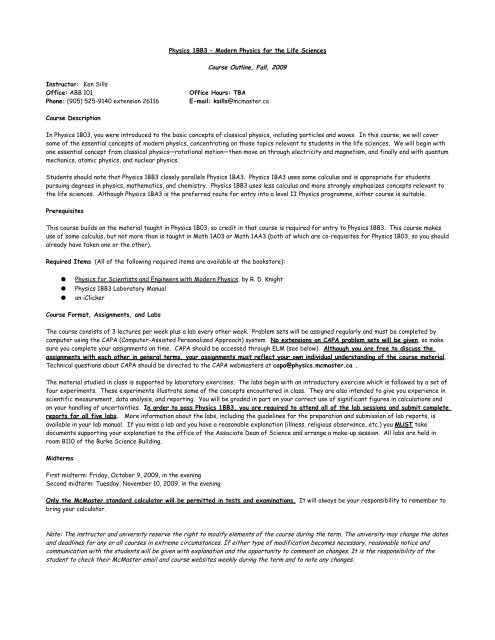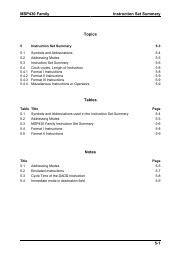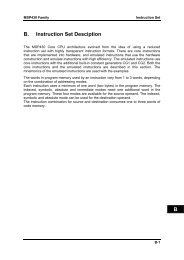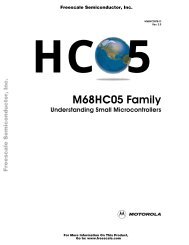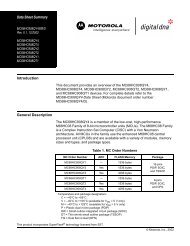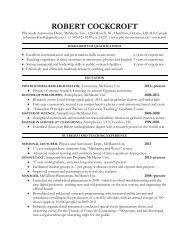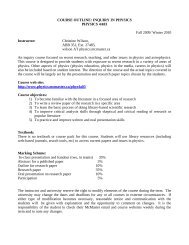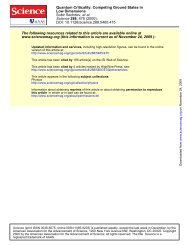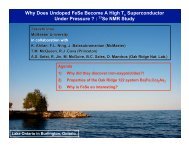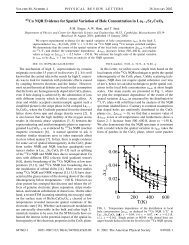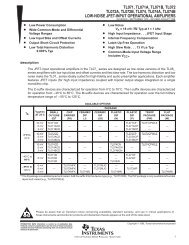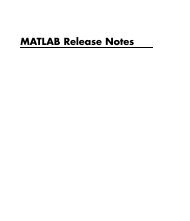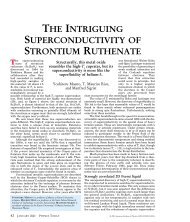Physics 1BB3 â Modern Physics for the Life Sciences Course ...
Physics 1BB3 â Modern Physics for the Life Sciences Course ...
Physics 1BB3 â Modern Physics for the Life Sciences Course ...
You also want an ePaper? Increase the reach of your titles
YUMPU automatically turns print PDFs into web optimized ePapers that Google loves.
<strong>Physics</strong> <strong>1BB3</strong> – <strong>Modern</strong> <strong>Physics</strong> <strong>for</strong> <strong>the</strong> <strong>Life</strong> <strong>Sciences</strong><br />
<strong>Course</strong> Outline, Fall, 2009<br />
Instructor: Ken Sills<br />
Office: ABB 101<br />
Phone: (905) 525-9140 extension 26116<br />
Office Hours: TBA<br />
E-mail: ksills@mcmaster.ca<br />
<strong>Course</strong> Description<br />
In <strong>Physics</strong> 1B03, you were introduced to <strong>the</strong> basic concepts of classical physics, including particles and waves. In this course, we will cover<br />
some of <strong>the</strong> essential concepts of modern physics, concentrating on those topics relevant to students in <strong>the</strong> life sciences. We will begin with<br />
one essential concept from classical physics—rotational motion—<strong>the</strong>n move on through electricity and magnetism, and finally end with quantum<br />
mechanics, atomic physics, and nuclear physics.<br />
Students should note that <strong>Physics</strong> <strong>1BB3</strong> closely parallels <strong>Physics</strong> 1BA3. <strong>Physics</strong> 1BA3 uses some calculus and is appropriate <strong>for</strong> students<br />
pursuing degrees in physics, ma<strong>the</strong>matics, and chemistry. <strong>Physics</strong> <strong>1BB3</strong> uses less calculus and more strongly emphasizes concepts relevant to<br />
<strong>the</strong> life sciences. Although <strong>Physics</strong> 1BA3 is <strong>the</strong> preferred route <strong>for</strong> entry into a level II <strong>Physics</strong> programme, ei<strong>the</strong>r course is suitable.<br />
Prerequisites<br />
This course builds on <strong>the</strong> material taught in <strong>Physics</strong> 1B03, so credit in that course is required <strong>for</strong> entry to <strong>Physics</strong> <strong>1BB3</strong>. This course makes<br />
use of some calculus, but not more than is taught in Math 1A03 or Math 1AA3 (both of which are co-requisites <strong>for</strong> <strong>Physics</strong> 1B03, so you should<br />
already have taken one or <strong>the</strong> o<strong>the</strong>r).<br />
Required Items (All of <strong>the</strong> following required items are available at <strong>the</strong> bookstore):<br />
●<br />
●<br />
●<br />
<strong>Physics</strong> <strong>for</strong> Scientists and Engineers with <strong>Modern</strong> <strong>Physics</strong>, by R. D. Knight<br />
<strong>Physics</strong> <strong>1BB3</strong> Laboratory Manual<br />
an iClicker<br />
<strong>Course</strong> Format, Assignments, and Labs<br />
The course consists of 3 lectures per week plus a lab every o<strong>the</strong>r week. Problem sets will be assigned regularly and must be completed by<br />
computer using <strong>the</strong> CAPA (Computer-Assisted Personalized Approach) system. No extensions on CAPA problem sets will be given, so make<br />
sure you complete your assignments on time. CAPA should be accessed through ELM (see below). Although you are free to discuss <strong>the</strong><br />
assignments with each o<strong>the</strong>r in general terms, your assignments must reflect your own individual understanding of <strong>the</strong> course material.<br />
Technical questions about CAPA should be directed to <strong>the</strong> CAPA webmasters at capa@physics.mcmaster.ca .<br />
The material studied in class is supported by laboratory exercises. The labs begin with an introductory exercise which is followed by a set of<br />
four experiments. These experiments illustrate some of <strong>the</strong> concepts encountered in class. They are also intended to give you experience in<br />
scientific measurement, data analysis, and reporting. You will be graded in part on your correct use of significant figures in calculations and<br />
on your handling of uncertainties. In order to pass <strong>Physics</strong> <strong>1BB3</strong>, you are required to attend all of <strong>the</strong> lab sessions and submit complete<br />
reports <strong>for</strong> all five labs. More in<strong>for</strong>mation about <strong>the</strong> labs, including <strong>the</strong> guidelines <strong>for</strong> <strong>the</strong> preparation and submission of lab reports, is<br />
available in your lab manual. If you miss a lab and you have a reasonable explanation (illness, religious observance, etc.) you MUST take<br />
documents supporting your explanation to <strong>the</strong> office of <strong>the</strong> Associate Dean of Science and arrange a make-up session. All labs are held in<br />
room B110 of <strong>the</strong> Burke Science Building.<br />
Midterms<br />
First midterm: Friday, October 9, 2009, in <strong>the</strong> evening<br />
Second midterm: Tuesday, November 10, 2009, in <strong>the</strong> evening<br />
Only <strong>the</strong> McMaster standard calculator will be permitted in tests and examinations. It will always be your responsibility to remember to<br />
bring your calculator.<br />
Note: The instructor and university reserve <strong>the</strong> right to modify elements of <strong>the</strong> course during <strong>the</strong> term. The university may change <strong>the</strong> dates<br />
and deadlines <strong>for</strong> any or all courses in extreme circumstances. If ei<strong>the</strong>r type of modification becomes necessary, reasonable notice and<br />
communication with <strong>the</strong> students will be given with explanation and <strong>the</strong> opportunity to comment on changes. It is <strong>the</strong> responsibility of <strong>the</strong><br />
student to check <strong>the</strong>ir McMaster email and course websites weekly during <strong>the</strong> term and to note any changes.
Grading Scheme<br />
Your grade will be calculated approximately according to <strong>the</strong> weightings given below. However, I reserve <strong>the</strong> right to change <strong>the</strong> actual<br />
weightings used. I will in<strong>for</strong>m you of any such changes.<br />
Assignments (CAPA) 10%<br />
Labs (4) 15%<br />
Midterm Tests (2) 30%<br />
Final Exam 40%<br />
In-class clicker quizzes 5%<br />
Clicker Quizzes<br />
Clicker quizzes will be given frequently, usually more than once per lecture. Clicker quizzes are short comprehension tests, based on <strong>the</strong><br />
assigned readings and <strong>the</strong> material being discussed in class. They are meant to help you retain what you learn and to assess how well you are<br />
understanding. They are not meant to be very difficult. You are encouraged to discuss <strong>the</strong> clicker quizzes with one ano<strong>the</strong>r during class. If<br />
you find you are not doing well on <strong>the</strong> clicker quizzes, you should be asking more questions! All students are responsible <strong>for</strong> purchasing an<br />
iClicker and bringing it to every class. No clickers or spare batteries will be available on loan. Students must purchase and register <strong>the</strong>ir<br />
iClicker be<strong>for</strong>e <strong>the</strong> second class of term. Failure to purchase, register, and use an iClicker will result in <strong>the</strong> loss of marks. The iClickers can<br />
be registered by filling out <strong>the</strong> <strong>for</strong>m on this web page iclicker.com/registration .<br />
In <strong>the</strong> “Student ID” field on that web page, you MUST fill in your Mac ID, which is <strong>the</strong> username you use to log onto WebCT. iClickers can be<br />
purchased second-hand, but <strong>the</strong>y must be re-registered with your own in<strong>for</strong>mation. It is not possible to share an iClicker with ano<strong>the</strong>r<br />
student, even if you are in different classes. It is possible to use a single iClicker <strong>for</strong> all of your courses, as long as you register it with your<br />
Mac ID, as described above. You are <strong>for</strong>bidden to enter answers on ano<strong>the</strong>r student's iClicker. Any student found entering answers on an<br />
iClicker o<strong>the</strong>r than his or her own will be considered to have violated McMaster's academic integrity policy.<br />
ELM<br />
This course makes use of <strong>the</strong> online learning tool, ELM. If you do not already have an ELM account, you should sign up <strong>for</strong> one immediately and<br />
ensure that you are able to access <strong>the</strong> PHYS <strong>1BB3</strong> page. You can find out more about ELM and sign up <strong>for</strong> an account at elm.mcmaster.ca .<br />
Students should be aware that, when <strong>the</strong>y access <strong>the</strong> electronic components of this course, private in<strong>for</strong>mation such as first and last names,<br />
user names <strong>for</strong> McMaster e-mail accounts, and program affiliation may become apparent to all o<strong>the</strong>r students in <strong>the</strong> same course. The<br />
available in<strong>for</strong>mation is dependent on <strong>the</strong> technology used. Continuation in this course will be deemed consent to this disclosure. If you have<br />
any questions or concerns about such disclosure please discuss this with <strong>the</strong> course instructor. Additional in<strong>for</strong>mation about online services<br />
available to McMaster students is available at getonline.mcmaster.ca.<br />
Scientific Honesty and Academic Integrity<br />
You are expected to exhibit honesty and use ethical behaviour in all aspects of <strong>the</strong> learning process. Academic credentials you earn are<br />
rooted in principles of honesty and academic integrity. Academic dishonesty is to knowingly act or fail to act in a way that results or could<br />
result in unearned academic credit or advantage. This behaviour can result in serious consequences, e.g. <strong>the</strong> grade of zero on an assignment,<br />
loss of credit with a notation on <strong>the</strong> transcript (notation reads “Grade of F assigned <strong>for</strong> academic dishonesty”), and/or suspension or expulsion<br />
from <strong>the</strong> university.<br />
It is your responsibility to understand what constitutes academic dishonesty. For in<strong>for</strong>mation on <strong>the</strong> various kinds of academic dishonesty<br />
please refer to <strong>the</strong> Academic Integrity Policy, located at www.mcmaster.ca/academicintegrity .<br />
The following list illustrates only a few possible <strong>for</strong>ms of academic dishonesty:<br />
1. Plagiarism, e.g. submission of work that is not one’s own or <strong>for</strong> which o<strong>the</strong>r credit has been obtained. Copying ano<strong>the</strong>r student's<br />
CAPA answers falls into this category and is prohibited.<br />
2. Improper collaboration in group work. Although you do your labs in groups, <strong>the</strong> laboratory reports are to be <strong>the</strong> result of individual<br />
ef<strong>for</strong>ts and not <strong>the</strong> result of teamwork.<br />
3. Copying or using unauthorized aids in tests and examinations.<br />
4. Falsification or misrepresentation of data in laboratory reports.


